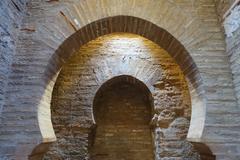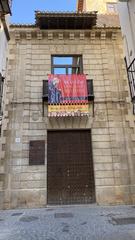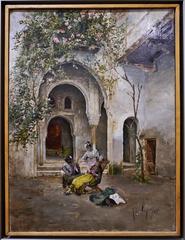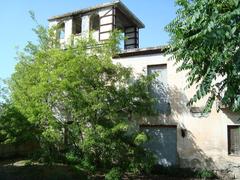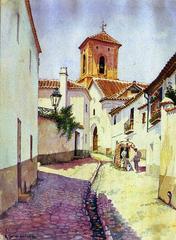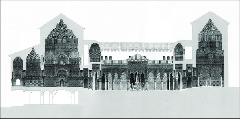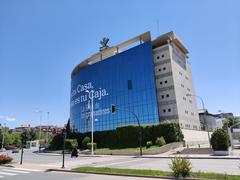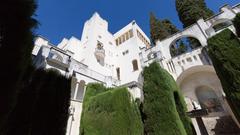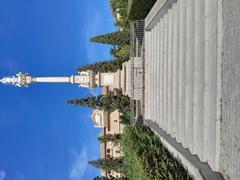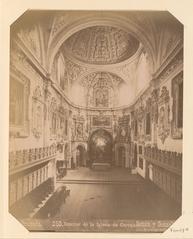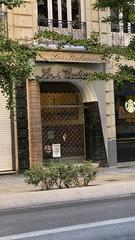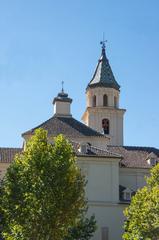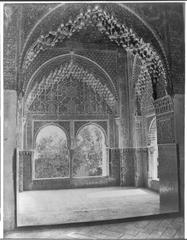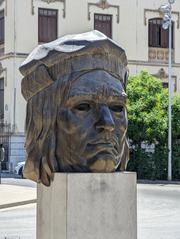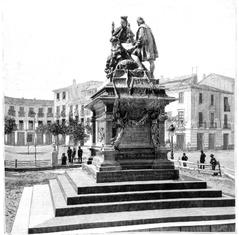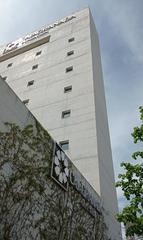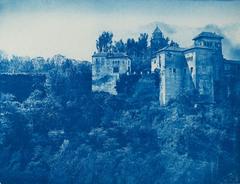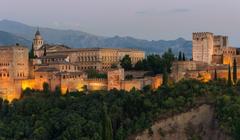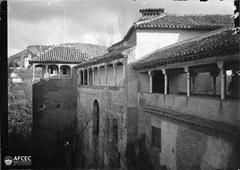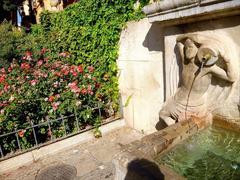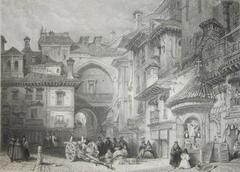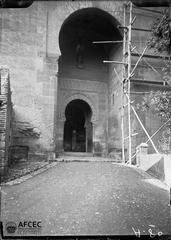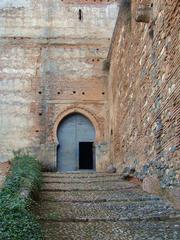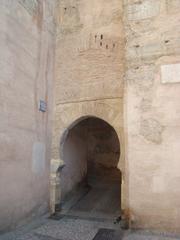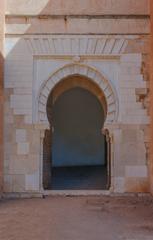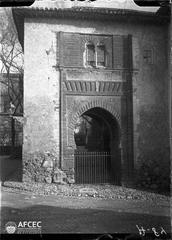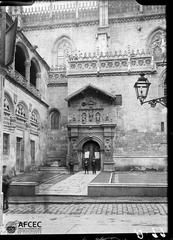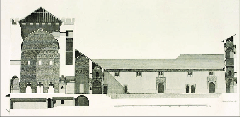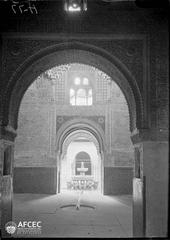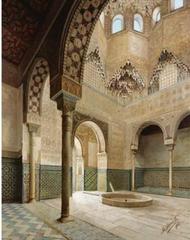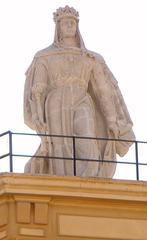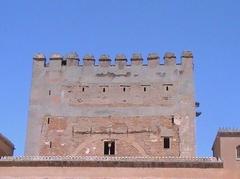Edificio Banco de Granada: Visiting Guide, Hours, and Insights into Granada’s Historical Sites
Date: 14/06/2025
Introduction
Granada, Spain, is celebrated for its remarkable historical landmarks—like the Alhambra and the Albaicín—but the Edificio Banco de Granada provides visitors with a different yet equally compelling perspective on the city’s evolution. Blending economic significance, layered architectural styles, and contemporary innovation, this building stands as a testament to Granada’s transition from medieval stronghold to modern urban center. Whether you are fascinated by history, architecture, or urban development, the Edificio Banco de Granada is an essential stop to better understand Granada’s multifaceted heritage.
For the most current visitor information, guided tours, and cultural events, consult the official Granada tourism website and the CajaGranada Foundation. (art-facts.com, Revista AD, Wikimedia Commons)
Table of Contents
- Early Urban and Economic Development of Granada
- The History and Architectural Significance of the Edificio Banco de Granada
- Visiting Information: Hours, Tickets, and Accessibility
- Guided Tours and Cultural Events
- Nearby Attractions and Travel Tips
- Role in Granada’s Modernization
- Preservation, Heritage Status, and Public Engagement
- Frequently Asked Questions (FAQ)
- Conclusion and Recommendations
- References
Early Urban and Economic Development of Granada
Granada’s cityscape has been sculpted by centuries of cultural and economic transformation, with financial institutions like the Edificio Banco de Granada playing a pivotal role in the city’s modernization. The late 19th and early 20th centuries saw Granada’s rapid economic growth, powered by agriculture, trade, and increasing integration into national and European financial networks. The establishment of banks such as the Banco de Granada provided the capital and infrastructure needed for businesses and urban projects, supporting the city’s participation in broader economic development. (art-facts.com)
The History and Architectural Significance of the Edificio Banco de Granada
Historical Overview
Constructed during a period of economic optimism, the Edificio Banco de Granada symbolizes Granada’s embrace of modernity. Although the building’s original construction date is not widely cited in travel guides, its status as a Bien de Interés Cultural (“Asset of Cultural Interest”) underscores its historical and architectural value. Throughout its history, the building has adapted to changing financial functions while retaining its prominence in Granada’s urban fabric. (Wikimedia Commons)
Architectural Features
The building is exemplary of early 20th-century Spanish bank architecture, combining neoclassical and eclectic elements that express stability and civic pride. Its grand façade, ornate stonework, and imposing entrance harmonize with nearby historical monuments, such as the Granada Cathedral and Royal Chapel, while also reflecting the modern ambitions of its era. Later, contemporary interventions—most notably the CajaGranada Headquarters designed by Alberto Campo Baeza and completed in 2001—introduced minimalist lines, strategic use of natural light, and integration of archaeological remains found during construction. The result is a dynamic dialogue between tradition and innovation. (Revista AD)
Visiting Information: Hours, Tickets, and Accessibility
Location
- Main Address: Avenida de la Ciencia, s/n, 18006 Granada, Spain
- Secondary Historic Location: Gran Vía de Colón, in the city center
Opening Hours
- Banking Offices: Monday to Friday, 8:30 am – 2:30 pm
- Cultural Spaces/Exhibitions: Hours vary; check the CajaGranada Foundation website for current schedules.
- Exterior Viewing: Accessible year-round
Tickets and Entry
- Exterior Viewing: Free, no ticket required.
- Cultural Events/Exhibitions: May require advance booking or tickets. Refer to event details on the CajaGranada Foundation website.
Accessibility
- The building is centrally located, easily reached by public transport (Metro Genil, city buses).
- The site and main public spaces are accessible for visitors with reduced mobility, featuring ramps and elevators.
- Parking is limited; public transport is recommended.
Guided Tours and Cultural Events
- Guided Tours: Occasional guided visits are available, often focusing on the building’s architecture and its archaeological integration. Booking is recommended via the CajaGranada Foundation or local cultural tour providers such as Granada Singular.
- Cultural Events: The site hosts exhibitions, lectures, and community events—often in partnership with the adjacent Museo de la Memoria de Andalucía.
- Photography: Photography is allowed in public and exhibition areas, though restrictions may apply during special events.
Nearby Attractions and Travel Tips
- Granada Cathedral: A Renaissance masterpiece just minutes away.
- Royal Chapel: Burial site of Ferdinand and Isabella.
- Alhambra: Iconic fortress-palace, accessible by bus or a scenic walk.
- Albaicín: Historic Moorish quarter, perfect for wandering and photography.
- Science Park (Parque de las Ciencias): Modern interactive museum near the contemporary headquarters.
Travel Tips:
- Visit during spring or autumn for the most comfortable weather and manageable crowds.
- Enjoy Granada’s tapas culture—many nearby cafes offer complimentary tapas with drinks.
- The central patio of the contemporary building is best photographed late morning to early afternoon for optimal light.
Role in Granada’s Modernization
The Edificio Banco de Granada and its successors reflect the city’s economic ambitions and its integration into the modern Spanish state. Banks like this provided financial support for new neighborhoods, infrastructure, and local industries, embodying a new era of urban optimism. The building itself—especially the contemporary CajaGranada Headquarters—demonstrates how financial institutions can inspire and shape the urban landscape. (art-facts.com)
Preservation, Heritage Status, and Public Engagement
Designated as a Bien de Interés Cultural, the Edificio Banco de Granada is protected as part of Spain’s architectural heritage. This recognition ensures ongoing preservation efforts, highlights the importance of 19th- and 20th-century architecture, and encourages public engagement with Granada’s modern history. The incorporation of archaeological remains, such as Almohad-period walls and a historic water reservoir, further cements its value as a living testament to Granada’s layered past. (Revista AD)
Frequently Asked Questions (FAQ)
Q: Is the Edificio Banco de Granada open to the public?
A: The building’s exterior can be admired at any time. Interior access is generally limited to business hours for banking operations or during special tours and events.
Q: Do I need tickets?
A: No ticket is required for the exterior or standard banking areas. Special exhibitions or guided tours may require tickets or reservations.
Q: Are guided tours available?
A: Yes, but they are occasional and require advance booking. Check the CajaGranada Foundation or local tour providers.
Q: Is the building accessible for visitors with disabilities?
A: Yes, ramps and elevators are available for visitors with reduced mobility.
Q: What are some nearby attractions?
A: Granada Cathedral, Royal Chapel, Albaicín, Alhambra, Science Park, and Museo de la Memoria de Andalucía.
Conclusion and Recommendations
The Edificio Banco de Granada is more than just a building—it is a symbol of Granada’s ongoing evolution, bridging the city’s medieval past and its contemporary aspirations. Its architectural and historical significance, coupled with its central location, make it a worthwhile stop for anyone exploring Granada’s rich heritage. Even for those unable to access the interior, the building’s façade and urban setting offer valuable insights into the city’s economic and cultural journey.
Plan your visit by consulting the CajaGranada Foundation and Granada tourism website for up-to-date information. Download the Audiala app for personalized recommendations, guided tours, and expert content about Granada’s historical and architectural gems.

